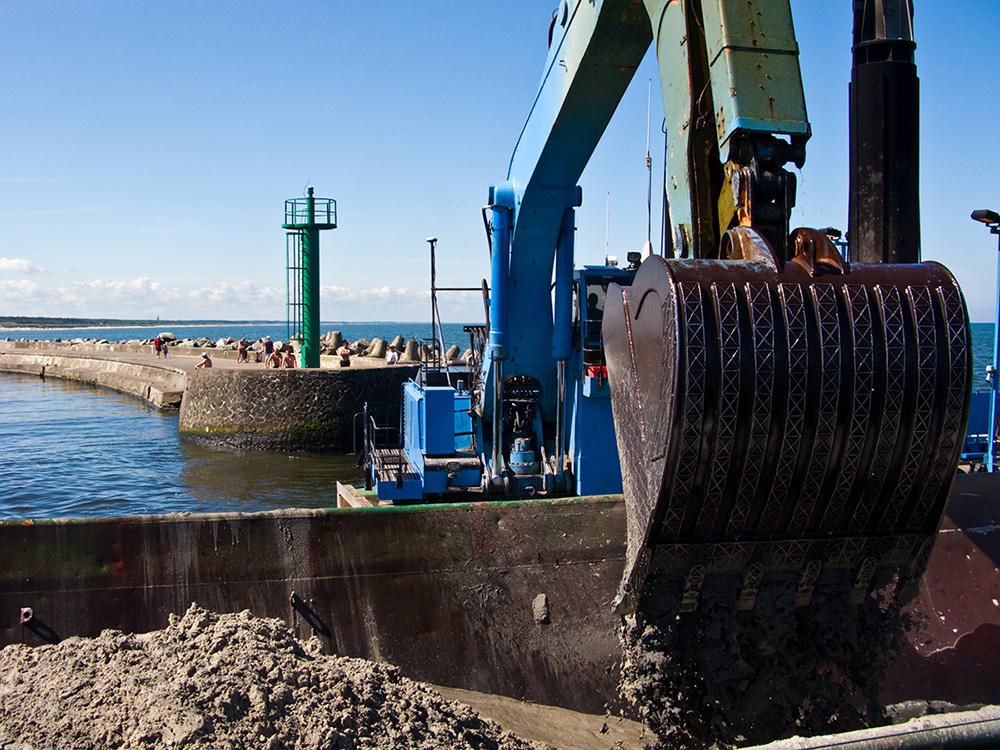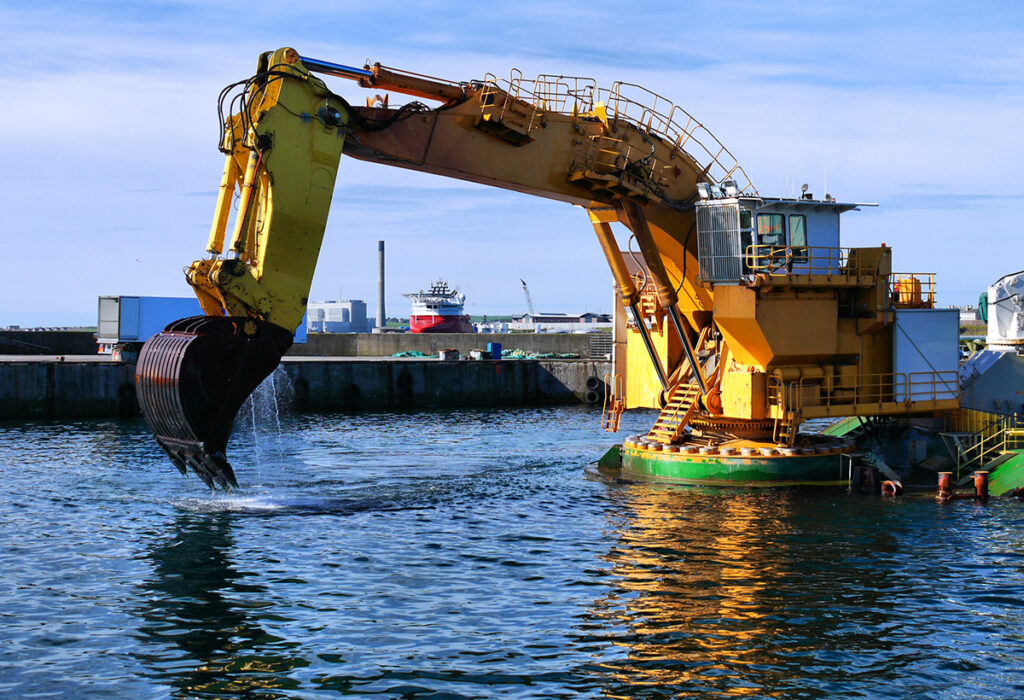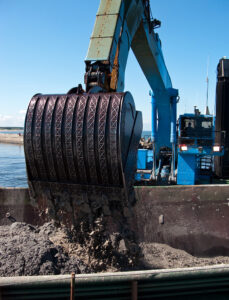Maintain proper port access or face consequences
By Jan Sierhuis* and Jesper Goodley Dannisøe**
2015, October 1: The access to any port is determined by the bathymetry in and around the harbour and to a large extent also to the type of seabed in the vicinity, basically distinguishing between sedimentary or solid rock seabed. The sea charts available for most Caribbean islands are based on information gathered during the last couple of centuries and the local charts for the harbours are probably based on more recent investigations. However, in some areas the bathymetry changes due to transport of sand and, for some harbours, it is a known fact that the access channels must be dredged periodically to keep the access at a more or less constant depth, as specified in the pilot descriptions.
The description of the bathymetry in and around the harbour will normally be divided into bathymetry in the access channels, if such are established, and bathymetry in the harbour. For larger ships the bathymetry outside the harbour may be very important to assess whether there is space enough to turn the ship, either before entering the port or after. This calls for updated bathymetry maps, especially in areas where sediment transport plays a role for changes in bathymetry, and the bathymetry surveys will also deliver information about the need for maintenance dredging.
The seabed composition may already be well-known to the harbour, if maintenance is done regularly. Reports from the dredging companies will indicate the type of seabed and accordingly also which equipment is needed for maintenance dredging. However, maintenance dredging will normally be restricted to removing sand which has moved into the access channels and harbour.

Figure 1: Example of modelling the net deposition of sediments from a dredging operation ( in g/m2).
INCREASE DEPTH OF ACCESS CHANNELS
If the present bathymetry conditions in both access channels and the harbour do not accommodate access of larger ships the alternatives are either to accept this and potentially be “removed” from the list of ports or to access whether new access channels and a deeper harbour is the solution. The information about the seabed conditions from previous studies can then be used to calculate whether it is at all possible to create access channels to the port or whether the distance to deeper water is simply too far. This may call for a new bathymetry survey to map potential transects where a new access channel can be established with the least dredging.

ENVIRONMENTAL IMPACTS
The environmental consequences from establishing a new access channel depends very much on the type of seabed and accordingly marine habitats, which will directly be impacted by the physical removal and which marine habitats adjacent to the dredging area will be impacted from sediment spills and from underwater noise from the dredging operation itself. Most marine species are capable of surviving sedimentation but the variation in the capability is species-dependent. Some types of corals are very sensitive to sedimentation and to the amount of suspended sediments in the water, whereas other species are more adaptable.
It is therefore necessary to carry out near-and-far field surveys to establish seabed and environmental baseline maps, which can be used for the planning. The channel transect with the least impacts can then be chosen and the consequences for the adjacent marine environment can be calculated and used in designing the optimal solution, which will provide a new channel and, at the same time, the least impact on the marine environment. If it is determined that sediment spreading is the largest threat to the environment, it is possible to use models to predict where the sediment will fall out and in what quantities.
Such calculations can then be used to set limits to the spill, which a dredging contractor must then fulfill by choosing dredging equipment that can meet the criteria. It is also important that the port authority, in cooperation with the relevant environmental authorities, establish a monitoring and management system that is capable of assessing whether the dredging contractor is in fact in compliance with the allowed spill. Forecast and hindsight modelling can help in assessing the actual sedimentation on specific locations and to check whether the results are in line with the expected conditions.
It should be borne in mind that there are short, medium and long-term impacts from establishing new or deeper channels and deepening harbours. Each type of impact must be considered individually to look at sedimentation tolerances and underwater noise, to find mitigating measures to lower the overall impacts.
With the right measures and investigation, it is indeed possible to change or establish new channels and deepen harbours with minimal impact on the marine environment, but only if the assessments are done with respect to the marine environment.
FINANCIAL, REGULATORY CONSIDERATIONS
Maintenance dredging is usually performed routinely, as business needs to continue. Most ports have an ongoing maintenance programme that may at regular intervals be evaluated to incorporate new demands and developments, or changes in local regulations and/or in dredging technology. The projected rise in sea levels and temperatures in the long run also impact the bathymetry of the harbour and current reef systems and marine life. To know and measure these effects allows ports to plan ahead and have their dredging permits approved by government and environmental partners in time. Ideally, existing vessel traffic should pay for maintenance dredging, usually by way of harbour dues or docking fees.
The introduction and updating of environmental regulations almost always lead to additional cost and an extension of the preparation period to obtain the necessary permits. Such regulation often leads to the use of new, more environment-friendly dredging technology, which may or may not be more expensive. The use of smart technology helps to keep pace with developments on both the regulatory and technological side and may lead to substantial cost savings in the longer term.
It is good management practice not to charge the vessels for new environmental regulations, or the introduction of new technology, as these are aimed at long-term cost savings. An exception may be made for solving issues caused directly by a particular type of ship or operation that requires additional measures.
DREDGING FOR LARGER SHIPS
 Of a different dimension are dredging projects aimed at allowing larger ships to enter and use the port. These are usually part of a larger port expansion project, as larger vessels also require larger infrastructure and handling equipment. Technically, such projects may not differ much from regular maintenance projects.
Of a different dimension are dredging projects aimed at allowing larger ships to enter and use the port. These are usually part of a larger port expansion project, as larger vessels also require larger infrastructure and handling equipment. Technically, such projects may not differ much from regular maintenance projects.
However, from a management perspective, they must be approached quite differently. Individual ports are part of a regional sea transport system, which in turn is connected to the larger world transport system of which the Caribbean is a part.
What is the financial and economic impact of such dredging projects? This will depend heavily on the function of the port in the regional transport system, before and after the dredging project. To this end, we can group Caribbean ports into different ‘levels’, from the ‘first tier’ global hub ports (for example, the major ports in Panama, Jamaica and the Bahamas), to the ‘second tier’ ports of the Caribbean region, like Port of Spain, Cartagena, and Rio Haina, to the ‘third tier’ local terminals in the Lesser Antilles.
MAIN HUB PORTS
The business models of these ports are driven by global indicators and , by necessity, they need to take an aggressive marketing approach. They will want to be the first, the biggest and the best, not to attract the ships but rather the cargo. The ships are merely a tool to get the cargo to the terminal.
Dredging costs for such ports are not recovered from increased vessel traffic and port dues, but from increased cargo handling fees. If the port does not invest in time, it may lose its market position. If, however, it succeeds, the rewards in terms of cargo volume increases are substantial. Dredging is therefore ‘pushed’ by global developments and cargo is paramount.
REGIONAL TERMINALS
 Regional terminals tie into one or several of the regional main hub ports and they play a role in pushing regional transshipment cargo from the main hubs deeper into the Caribbean. Such terminals operate under pressure, as the main lines and hubs are pushing for larger feeder vessels to get regional cargo out of the hub terminal quicker and cheaper, while they depend on the third tier ‘hinterland’ ports to provide the cargo volume increases to pay for the bigger ships, the dredging and the infrastructure required to handle them. Hence, these ports need to finance their expansion mainly on projected vessel calls. And these may in fact decrease with the use of larger ships. Only when their hinterland ports draw in more cargo, will they make money on this expansion.
Regional terminals tie into one or several of the regional main hub ports and they play a role in pushing regional transshipment cargo from the main hubs deeper into the Caribbean. Such terminals operate under pressure, as the main lines and hubs are pushing for larger feeder vessels to get regional cargo out of the hub terminal quicker and cheaper, while they depend on the third tier ‘hinterland’ ports to provide the cargo volume increases to pay for the bigger ships, the dredging and the infrastructure required to handle them. Hence, these ports need to finance their expansion mainly on projected vessel calls. And these may in fact decrease with the use of larger ships. Only when their hinterland ports draw in more cargo, will they make money on this expansion.
Such projects, therefore, are ‘pushed’ by global transport developments in the hub ports and ‘pulled’ by economic developments in their hinterland ports. For such projects, it is essential to finance the dredging from the port dues as the ships, which may or may not come on any given time, are paramount and cargo is only the cherry on the pie.
LOCAL HINTERLAND PORTS
In the Caribbean, most if not all local terminals are driven by inbound cargo. Only in dedicated (break) bulk export terminals is this different. The Caribbean economies are on a relatively high level, but their growth rates are not exceptionally high and are nowadays dependent mainly on tourism, which is vulnerable to developments in the source markets.
The smaller ships visiting such ports tend to be deployed more flexibly in the region, or they operate on tramp routes. Cargo volumes fluctuate by season and some routes for this reason are seasonal, or smaller vessels are deployed in the off season. If such ports wish to remain included in the scheduled regional transport system, they may be forced to expand even in circumstances where cargo volumes do not and will not increase substantially. In such cases, the expansion has to be financed fully from port dues and the lines may not always be willing to pay for this – they will pass it on to the local customers.
DREDGING FOR LARGER CRUISE SHIPS
Basically, passengers are the cargo of cruise ships. And the cruise market dictates size increases in cycles. If you want to be in the business as a major cruise
port, you need to expand regularly. Unfortunately, the passenger preferences not only dictate where the ship goes, but also the route it will take to get there. Hence, cruise itineraries have a ‘life cycle’ that you need to understand. There is one advantage: if the bigger
ship comes, the passenger volumes will also increase, providing huge opportunities for the port and the community to generate additional revenue. In many ways, cruise ports resemble main hub cargo ports: the passenger, not the vessel, is paramount and should drive your dredging project.
Ports must take the seasonality of the Caribbean cruise market into consideration, particularly ports further away from the main home ports. Sometimes it pays to make cruise berths multi-purpose (e.g. for bunkering or cargo of other ships), so as to increase the ship tonnage going through the terminal.
REGIONAL PORT EXPANSION APPROACH
As regards the environment, when dredging for expansion, new bathymetry surveys are required and an environmental impact study should be performed to determine the long-term effects of the dredging project and the planned terminal expansion.
From a management perspective, ports need to finance maintenance dredging from existing vessel traffic. For expansions, import-driven cargo ports need a thorough understanding of what drives their project: global, regional or local demand that is either vessel or cargo driven, or both. It helps to take a regional or global approach and it may be wise to discuss the project with neighboring ports up and down the transport chain.
Cruise ports must act like main hub ports and must have long-term development agreements with cruise lines to secure increased passenger volumes, before embarking on any major expansion project.
The dredging usually can be financed from increased port dues coming from more ship tonnage piloted in, that is if the number of cruise itineraries and vessel calls remain stable. []
*  Jan Sierhuis, Director, Maritime Authority of Curacao. maritimecuracao@gmail.com
Jan Sierhuis, Director, Maritime Authority of Curacao. maritimecuracao@gmail.com
 ** Jesper Goodley Dannisøe, Senior Project Manager, DHI Denmark
** Jesper Goodley Dannisøe, Senior Project Manager, DHI Denmark
(jda@dhigroup.com)





